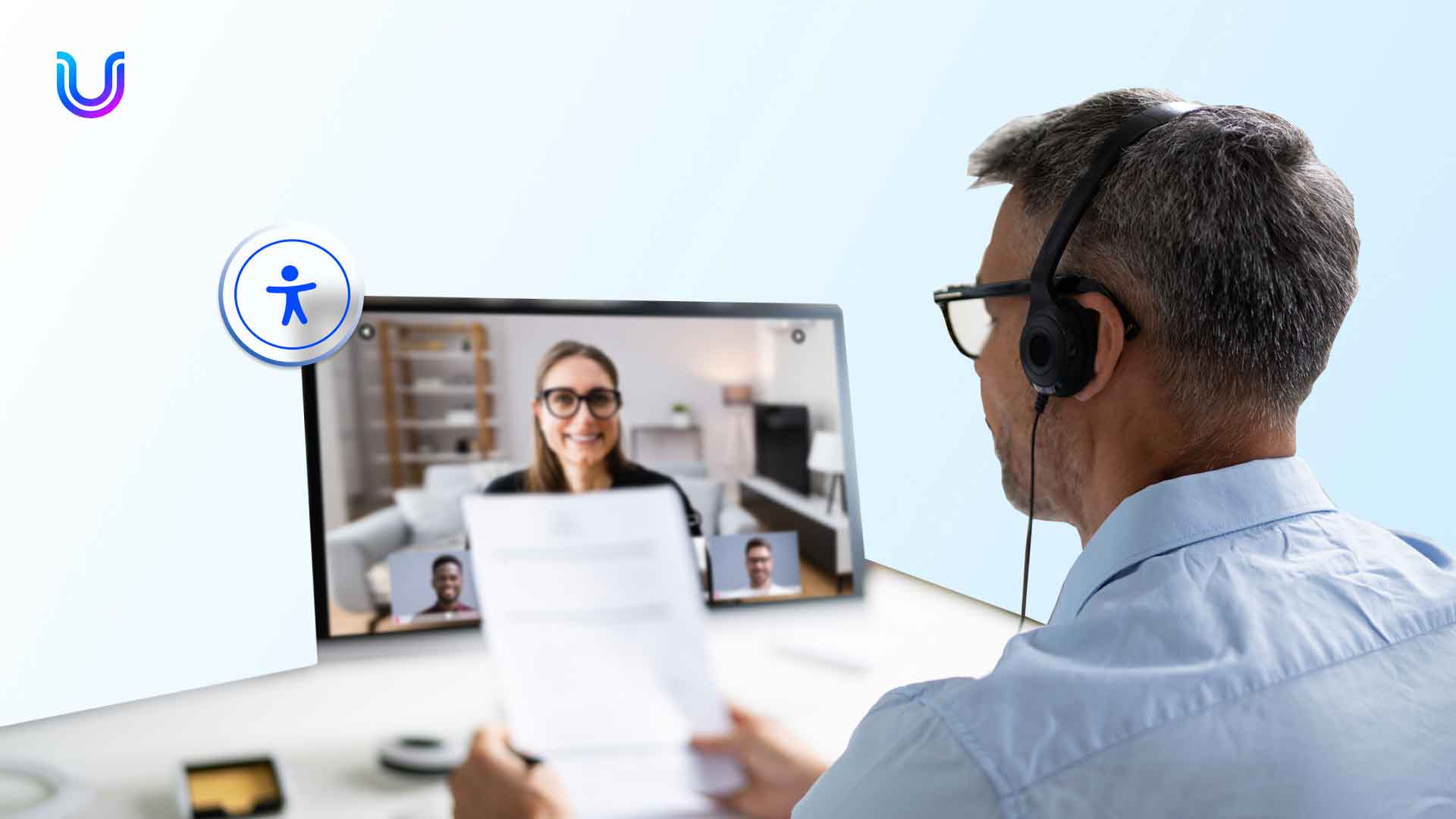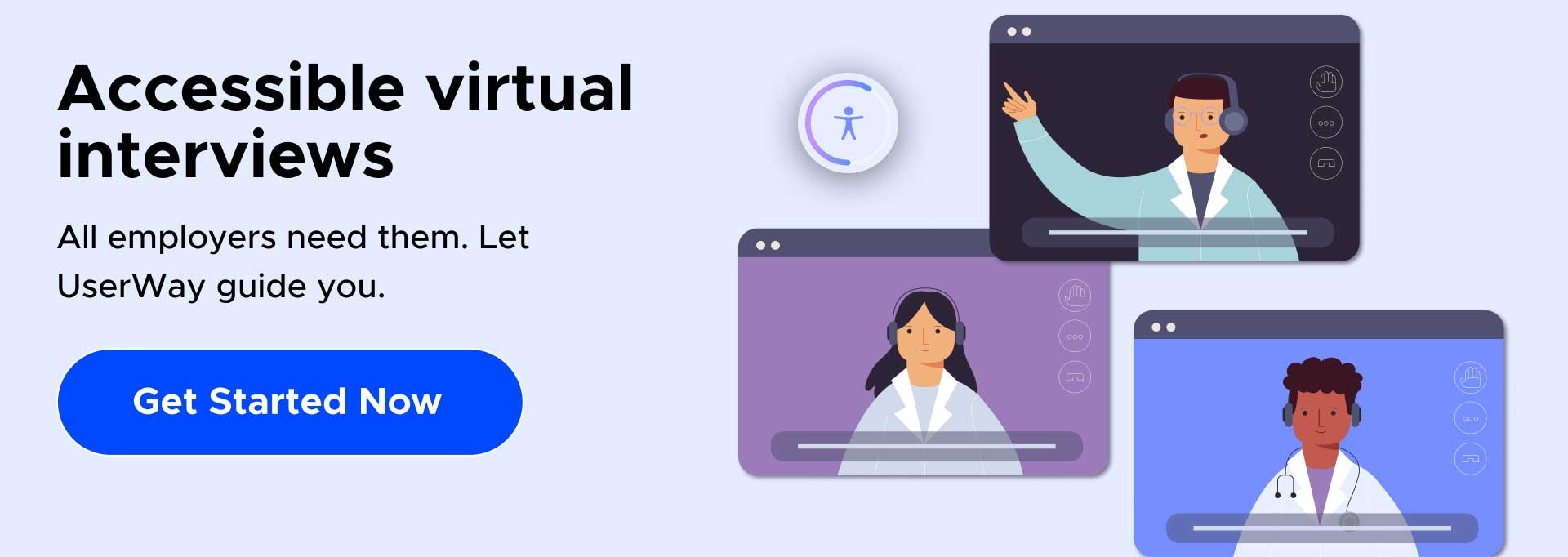Virtual Interviews and Accessibility: Key Insights and Best Practices

The traditional job interview has profoundly transformed in today’s fast-paced world. Gone are the stuffy conference rooms and awkward handshakes, with virtual interviews becoming the norm. As technology continues to reshape how we connect and communicate, it’s increasingly critical to make interviews inclusive of people with different abilities. Digital accessibility, or the ability for people with disabilities to use and interact with digital content, should be a fundamental concern for any company. This blog post explores the rise of virtual interviews and their crucial relationship with digital accessibility.
Let’s look at the post-pandemic rise of online interviews and their related accessibility challenges.
Virtual Interviews & Accessibility Challenges
The COVID-19 pandemic played a significant role in accelerating the adoption of virtual interviews. As organizations sought to continue their hiring processes while adhering to safety guidelines, video conferencing platforms like Zoom, Microsoft Teams, and Skype became the go-to interview tools. With the rise of digital accessibility, technology and digital content are usable by everyone, including people with disabilities. As in-person interviews shift to digital platforms, it’s crucial to consider how digitally accessible these platforms are.
Beyond the pandemic, virtual interviews offer numerous advantages, including cost savings, flexibility, and the ability to connect with candidates worldwide. But they also pose significant accessibility challenges, including:
-
Technological Barriers
Some individuals with disabilities may face difficulties in using the technology required for virtual interviews, such as webcams, microphones, or screen sharing. Employers must offer technical support and accommodations.
-
Communication Challenges
Virtual interviews can disrupt natural communication cues, making it harder for candidates with hearing impairments or speech disabilities to convey their thoughts effectively. Closed captioning and video relay services can help bridge these gaps.
-
Access to Documents
Inaccessible interview materials, such as PDFs without proper tagging, can hinder candidates with visual impairments from accessing essential information. Providing materials in accessible formats is crucial.
Next, we look at best interview practices that support diversity, equity, and inclusion.
Online Interviews: How to Provide Digital Accessibility
Inclusive design, a fundamental concept in digital accessibility, revolves around creating products, services, and environments accessible to as many people as possible, regardless of their abilities. To provide an inclusive virtual interview, consider implementing the following best practices:
- Platform Selection: choose digitally accessible video conferencing platforms. For instance, some venues offer built-in assistive technology features like screen reader compatibility and keyboard navigation.
- Accessible Content: provide accessible content like job descriptions and interview materials—use clear and concise language, provide alternative text for images, and offer accessible document formats like PDFs with proper tagging.
- Testing and Training: Recruiters and interviewers should receive training on digital accessibility best practices, including understanding how to use accessibility features of communication platforms, ensuring the availability of closed captions, and providing technical support for candidates who require it.
- Employers should ask interview questions with diversity, equity, and inclusion in mind.
- Platform Accessibility: Choose video conferencing platforms that prioritize accessibility and provide features like screen reader compatibility and keyboard navigation.
- Accessible Documents: Ensure all interview materials are in accessible formats, such as HTML or plain text, and include alternative text for images.
- Closed Captioning: Use closed captioning for video interviews to make the content accessible to deaf and hard-of-hearing candidates.
- Technical Support: Offer technical support to candidates needing assistance setting up and using the necessary technology.
- Training: Train interviewers and recruiters on digital accessibility best practices to create an inclusive interview process.
- Flexibility: Be flexible with scheduling and accommodations to ensure candidates with disabilities have an equal opportunity to participate in interviews.
- Feedback and Improvement: Collect feedback from candidates about their virtual interview experience and use it to improve accessibility continually.
- Systemic Accessibility: Digital inclusion is a company-wide effort. Do you have suitable systems and platforms in place? Are your internal communications digitally accessible?
- Is our organization accessible physically with suitable space, layout, and assistive technology?
- Is our company culture inclusive, welcoming, and open to working with people who are different?
Legal and Ethical Considerations
Ignoring digital accessibility in virtual interviews can have legal and ethical consequences. Many countries, including the United States, have laws like the Americans with Disabilities Act (ADA) and the Web Content Accessibility Guidelines (WCAG) that require organizations to provide equal access to their digital content. These standards are necessary to help prevent potential lawsuits and damage to your company’s reputation.
Even more critical, promoting digital accessibility in virtual interviews isn’t just a matter of compliance but an ethical responsibility. Inclusivity and diversity are essential values in today’s world, and ensuring that virtual interviews are accessible is a step toward achieving these goals.
Virtual Interviews Have Real-World Consequences
The rise of virtual interviews is a significant advancement in the world of recruitment, offering cost savings, flexibility, and access to a broader talent pool. However, it’s crucial to recognize the critical relationship between virtual interviews and digital accessibility. By embracing inclusive design, addressing accessibility challenges, and following best practices, organizations can ensure that virtual interviews are accessible to all candidates, regardless of their abilities. In doing so, they not only meet legal requirements but also uphold values that help create a more diverse and inclusive workforce for the future.
Learn why UserWay should be your accessibility and compliance partner.
UserWay: For ALL Your Digital Inclusion Needs
Digital accessibility is essential for hiring practices and your internal and external communications. Learn how you can benefit from UserWay’s full range of assistive tech tools, commission-driven partnerships, and enterprise solutions.
Answers to Common FAQs
What Are Some Handy Tips for Accessible Interviews?
- Enable lipreading: ensure the lighting in the interview room is good so the candidate can see the interviewer’s lips.
- Give the candidate the interview questions on paper just before the interview starts.
- Provide a hearing loop system if the candidate requires one.
What Can You Miss in a Virtual Interview?
Non-verbal communication, like smiling, head nodding, and head tilting, is harder to detect. Pay closer attention to these cues that are easier to see in person.
What’s A Common Red Flag For Online Interviews?
When you notice the candidate lacks the initiative to showcase their skills, even when you go out of your way to ask the proper questions and make them feel comfortable.





Share